反射
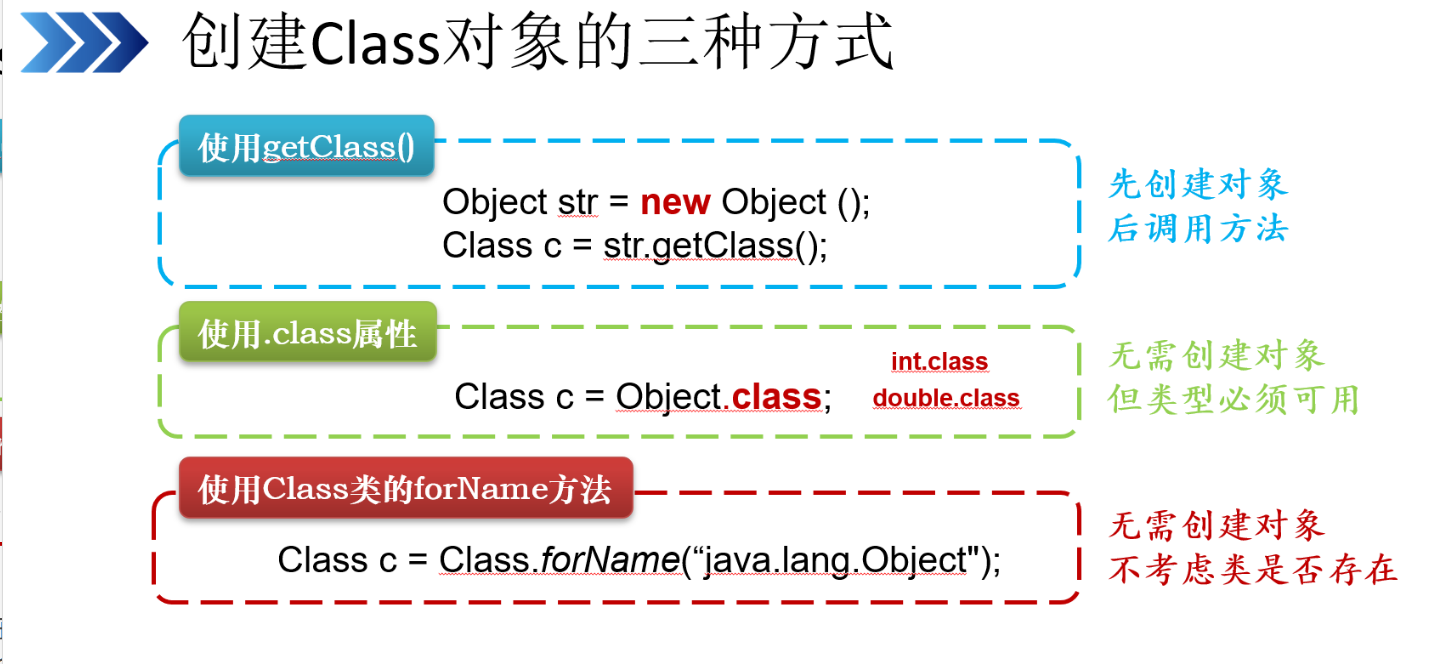
通过 Java 反射机制,可以在程序中访问已经装到JVM 中的 Java 对象的描述现访同、检测和修改描述Java 对象本身信息的功能。
众所周知,所有 Java 类均继承了 Object 类,在 Object 类中定义了一个getClass0方法,该方法运回一个类型为Class的对象。例如下面的代码:
JTextFieid textField = new JTextField0; //创建JTextField 对象
Class textFieldC = textField.getClass(); //获取 Class 对象
利用Class类的对象 textFieldC,可以访问用来返回该对象的 textField 对象的描述信息。可以访问的主要描述信息如表所示

访问构造方法
在通过下列一组方法访问构造方法时,将返回Constructor类型的对象或数组。每个Constructor对象代表一个构造方法,利用Constructor对象可以操纵相应的构造方法:
- getConstructors()
- getConstructor(Class<?>...parameterTypes)
- getDeclaredConstructors()
- getDeclaredConstructor(Class<?>...parameterTypes)
如果是访问指定的构造方法,需要根据该构造方法的入口参数的类型来访问。例如,访问一个入口参数类型依次为String型和int型的构造方法,通过下面两种方式均可实现:
objectClass.getDeclaredConstructor(String.class,int.class);
objectClass.getDeclaredConstructor(new Class[]{ String.class, int.class }):
Constructor类中提供的常用方法如所示。
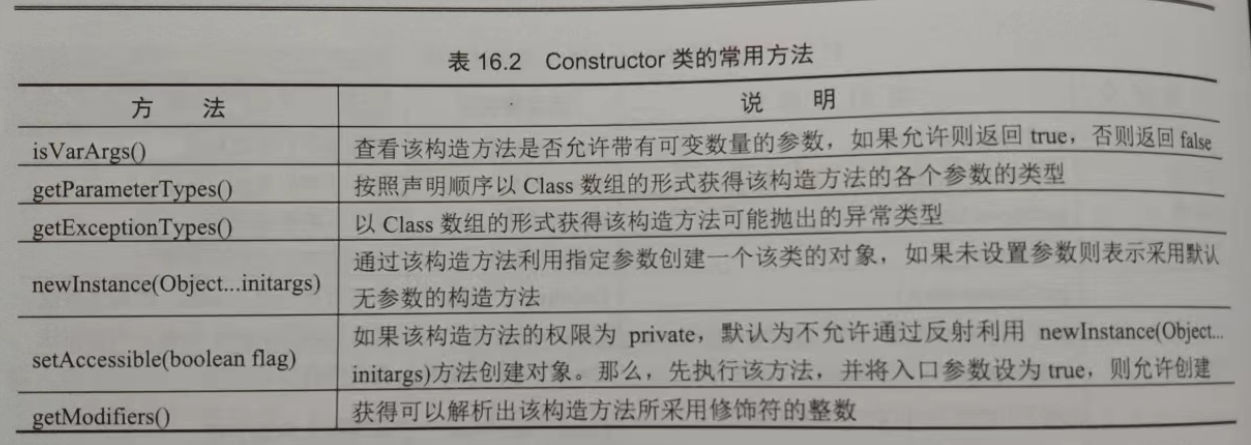
通过 java.lang.reflect.Modifier 类可以解析出 getModifiers0方法的返回值所表示的修饰符信息,在该类中提供了一系列用来解析的静态方法,既能查看是否被指定的修饰符修饰,又能以字符串的形式获得所有修饰符。Modifier 类常用静态方法如所示。

例如,判断对象constructor 所代表的构造方法是否被 private 修饰,以及以字符串形式获得该构造方法的所有修饰符的典型代码如下:
int modifiers = constructor.getModifiers();
boolean isEmbellishByPrivate = Modifier.isPrivate(modifiers);
String embellishment = Modifier.toString(modifiers);
代码案例:
package com.mr;
public class Demo1 {
String s;
int i, i2, i3;
private Demo1() {
}
protected Demo1(String s, int i) {
this.s = s;
this.i= i;
}
public Demo1(String... strings) throws NumberFormatException{
if (0 < strings.length)
i= Integer.valueOf(strings[0]);
if (1 < strings.length)
i2 =Integer.valueOf(strings[1]);
if (2 < strings.length)
i3 = Integer.valueOf(strings[2]);
}
public void print() {System.out.println("s=" + s);
System.out.println("i="+ i);
System.out.println("i2=" + i2);
System.out.println("i3="+ i3);
}
}然后编写测试类ConstructorDemo1,在该类中通过反射访问com.mr.Demo1类中的所有构造方法并将该构造方法是否允许带有可变数量的参数、入口参数类型和可能抛出的异常类型信息输出到控台。具体代码如下:
package com.mr;
import java.lang.reflect.Constructor;
public class ConstructorDemo1 {
public static void main(String[] args) {
Demo1 d1 = new Demo1("10","20","30");
Class<? extends Demo1> Demo1Class = d1.getClass();
//获得所有构造方法
Constructor[] declaredConstructors = Demo1Class.getDeclaredConstructors();
for (int i= 0; i < declaredConstructors.length; i++) { //遍历构造方法
Constructor<?> constructor = declaredConstructors[i];
System.out.println("查看是否允许带有可变数量的参数:"+constructor.isVarArgs());
System.out.println("该构造方法的入口参数类型依次为:");
Class[] parameterTypes =constructor.getParameterTypes(); //获取所有参数类型
for (int j= 0; j< parameterTypes.length; j++) {
System.out.println(""+ parameterTypes[j]);
}
System.out.println("该构造方法可能抛出的异常类型为:");
//获得所有可能抛出的异常信息类型
Class[] exceptionTypes = constructor.getExceptionTypes();
for (int j= 0; j< exceptionTypes.length; j++) {
System.out.println("" + exceptionTypes[j]);
}
Demo1 d2 = null;
while (d2 == null) {
try{ //如果构造方法的访问权限为 private或 protected,则抛出异常,即不允许
if(i ==2) //通过执行默认没有参数的方法创建对象
d2 =(Demo1) constructor.newInstance();
else if (i == 1)
//通过执行具有两个参数的构造方法创建对象
d2 =(Demo1)constructor.newInstance("7", 5);
else{//通过执行具有可变数量参数的构造方法创建对象
Object[] parameters = new Object[] { new String[] { "100","200","300" }};
d2 =(Demo1) constructor.newInstance(parameters);
}
}catch (Exception e) {
System.out.println("在创建对象时抛出异常,下面执行 setAccessible()方法");
constructor.setAccessible(true); //设置为允许访问
}
}
if (d2 != null) {
d2.print();
System.out.println();
}
}
}
}运行结果如下:
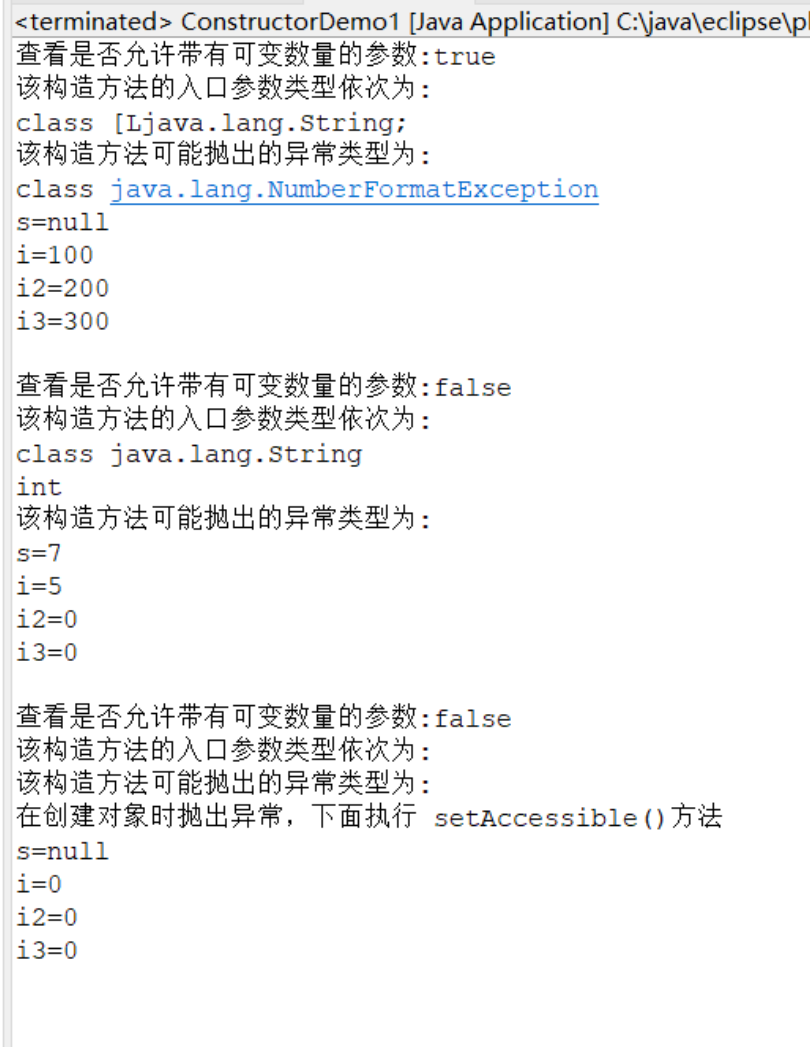
当反射无参构造方法时将输出所有属性的默认值,当反射有参数的构造方法时将输方法参数赋予的相应值。
访问成员变量
在通过下列一组方法访问成员变量时,将返回 Field 类型的对象或数组。每个 Fied 对象代表一个成员变量,利用 Field 对象可以操纵相应的成员变量:
- getFields()
- getField(String name)
- getDeclaredFields()
- getDeclaredField(String name)
如果是访问指定的成员变量,可以通过该成员变量的名称来访问。例如,访问一个名称为 birthday的成员变量,访问方法如下:
object. getDeclaredField("birthday");
Field类中提供的常用方法如表 16.4 所示。
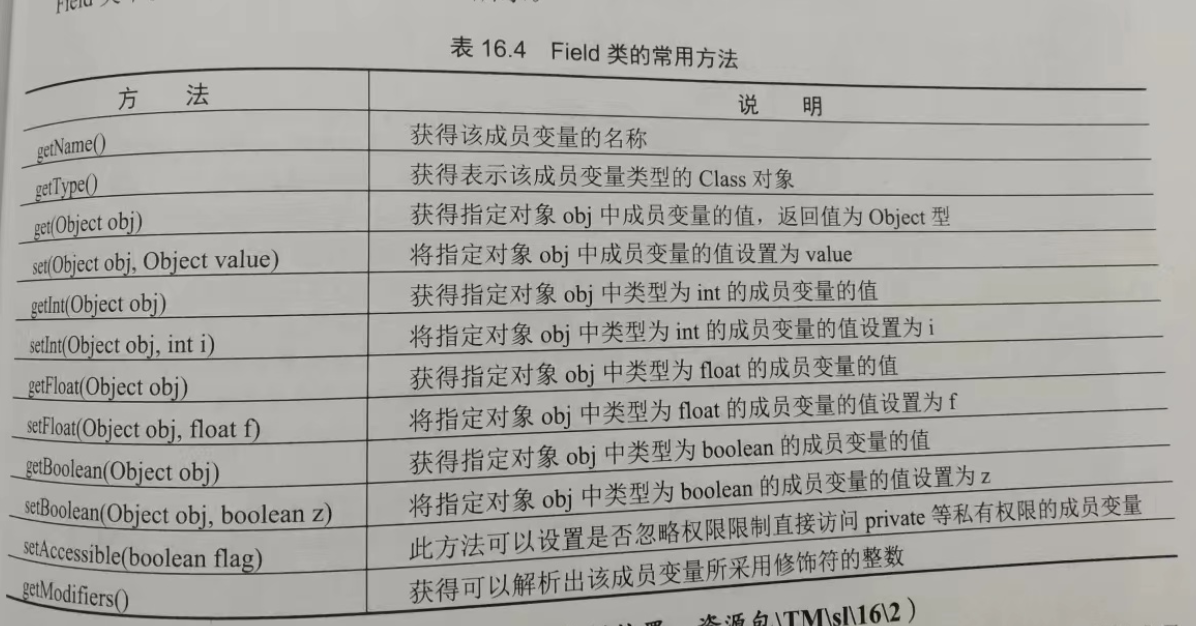
代码案例:
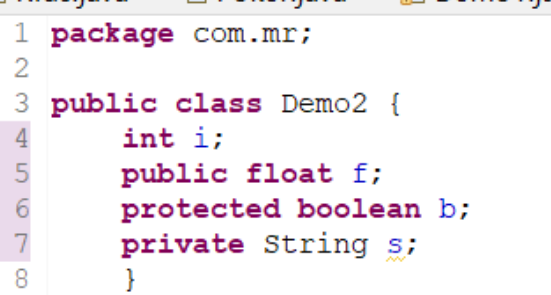
然后通过反射访问com.mrDemo2类中的所有成员变量将成员变量的名称和类型信息输出到控制
台,并分别将各个成员变量在修改前后的值输出到控制台。关键代码如下:
package com.mr;
import java.lang.reflect.Field;
public class Demo2 {
public static void main(String[] args) {
F example =new F();
Class exampleC = example.getClass();
Field[] declaredFields = exampleC.getDeclaredFields(); //获得所有成员变量
for (int i= 0;i < declaredFields.length; i++) { //遍历成员变量
Field field = declaredFields[i];
System.out.println("名称为: "+ field.getName()); //获得成员变量名称并输出
Class fieldType = field.getType(); //获得成员变量类型
System.out.println("类型为:"+fieldType);
boolean isTurn = true;
while (isTurn) {
//如果该成员变量的访问权限为 private 或 protected,则抛出异常,即不允许访问
try {
isTurn = false;
//获得成员变量值
System.out.println("修改前的值为:"+ field.get(example));
if (fieldType.equals(int.class)) { //判断成员变量的类型是否为 int型
System.out.println("利用方法 setlnt()修改成员变量的值");
field.setInt(example,168);//为 int 型成员变量赋值
}else if (fieldType.equals(float.class)){ //判断成员变量的类型是否为 float型
System.out.println("利用方法 setFloat()修改成员变量的值");
field.setFloat(example, 99.9F);//为 float 型成员变量赋值
}else if (fieldType.equals(boolean.class)){//判断成员变量的类型是否为 boolean型
System.out.println("利用方法 setBoolean()修改成员变量的值");
field.setBoolean(example, true);//为 boolean 型成员变量赋值
}else {
System.out.println("利用方法 set()修改成员变量的值");
field.set(example,"MWQ");//可以为各种类型的成员变量赋值
}
//获得成员变量值
System.out.println("修改后的值为:"+ field.get(example));
} catch (Exception e) {
System.out.println("在设置成员变量值时抛出异常,"+"下面执行 setAccessible()方法!");
field.setAccessible(true);//设置为允许访问
isTurn = true;
}
}
System.out.println();
}
}
}
运行结构如下:
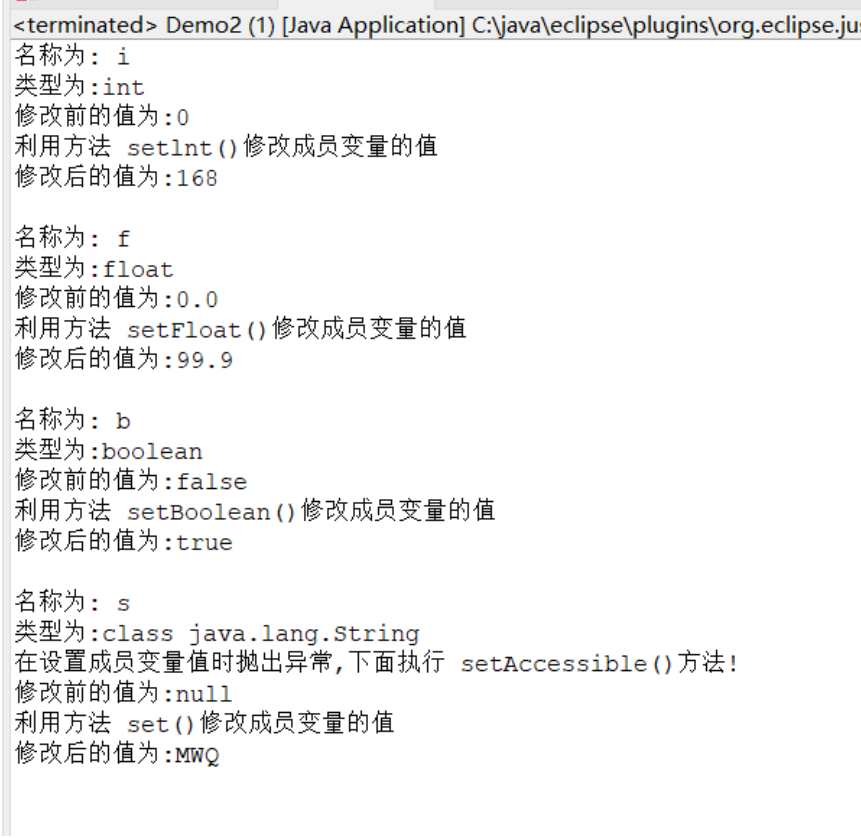
通过这个结果可以看出,在反射权限为 private和 protected 的成员变量时,需要执行 setAccessible0方法,并将入口参数设为 true,否则不允许访问。
访问成员方法
在通过下列一组方法访问成员方法时,将返回 Method 类型的对象或数组。每个Method 对象代表一个方法,利用Method 对象可以操纵相应的方法:
getMethods()。
getMethod(String name, Class<?>...parameterTypes)。
getDeclaredMethods()。
getDeclaredMethod(String name, Class<?>...parameterTypes)。
如果是访问指定的方法,需要根据该方法的名称和入口参数的类型来访问。例如,访问一个名称为print、入口参数类型依次为String 型和nt型的方法,通过下面两种方式均可实现:
objectClass.getDeclaredMethod("print",String.class, int.class);
objectClass.getDeclaredMethod("print", new Class (String.class, int.class ));
Method 类中提供的常用方法如表所示。
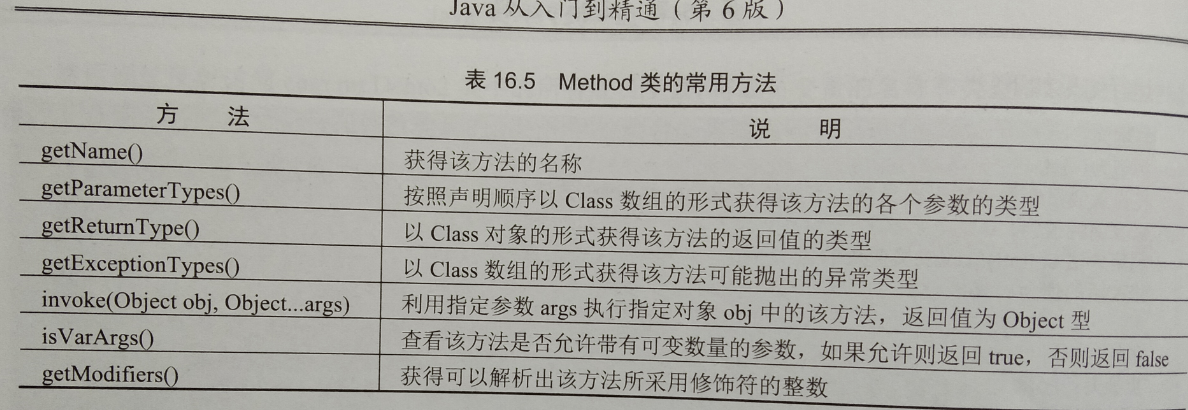
package com.mr;
public class D {
static void staticMethod() {
System.out.println("执行 staticMethod()方法");
}
public int publicMethod(int i) {
System.out.println("执行 publicMethod()方法");
return i*100;
}
protected int protectedMethod(String s, int i) throws NumberFormatException {
System.out.println("执行 protectedMethod()方法");
return Integer.valueOf(s) + i;
}
private String privateMethod(String... strings) {
System.out.println("执行 privateMethod()方法");
StringBuffer stringBuffer = new StringBuffer();
for (int i= 0; i< strings.length; i++) {
stringBuffer.append(strings[i]);
}
return stringBuffer.toString();
}
}然后通过反射访问 com.mr.Demo3 类中的所有方法,将各个方法的名称、入口参数类型、返回值类型等信息输出到控制台,并执行部分方法。关键代码如下:
package com.mr;
import java.lang.reflect.Method;
public class Demo3 {
public static void main(String[] args) {
D demo = new D();
Class demoClass = demo.getClass();
Method[] declaredMethods = demoClass.getDeclaredMethods(); //获得所有方法
for (int i = 0; i < declaredMethods.length; i++) { //遍历方法
Method method = declaredMethods[i];
System.out.println("名称为:"+method.getName()); //获得方法名称
System.out.println("是否允许带有可变数量的参数:"+method.isVarArgs());
System.out.println("入口参数类型依次为:");
Class[] parameterTypes = method.getParameterTypes(); //获得所有参数类型
for (int j= 0; j< parameterTypes.length; j++) {
System.out.println(""+ parameterTypes[j]);
}
System.out.println("返回值类型为:"+ method.getReturnType()); //获得方法返回值类型
System.out.println("可能抛出的异常类型有:");
//获得方法可能抛出的所有异常类型
Class[] exceptionTypes = method.getExceptionTypes();
for (int j= 0; j< exceptionTypes.length; j++) {
System.out.println(""+ exceptionTypes[j]);
}
boolean isTurn = true;
while (isTurn) {
try { //如果该方法的访问权限为 private 或 protected,则抛出异常,即不允许访问
isTurn = false;
if ("staticMethod".equals(method.getName()))
method.invoke(demo); //执行没有入口参数的方法
else if("publicMethod".equals(method.getName()))
System.out.println("返回值为:"+method.invoke(demo,168)) ;//执行方法
else if ("protectedMethod".equals(method.getName()))
System.out.println("返回值为:"+method.invoke(demo,"7",5));//执行方法
else if ("privateMethod".equals(method.getName())){//定义二维数组
Object[] parameters = new Object[]{ new String[] {"M","w","Q" }};
System.out.println("返回值为:"+ method.invoke(demo,parameters));
}
}catch(Exception e){
System.out.println("在执行方法时抛出异常,"+"下面执行setAccessible()方法!");
method.setAccessible(true);//设置为允许访问
isTurn = true;
}
}
System.out.println();
}
}
}
运行结果如下:
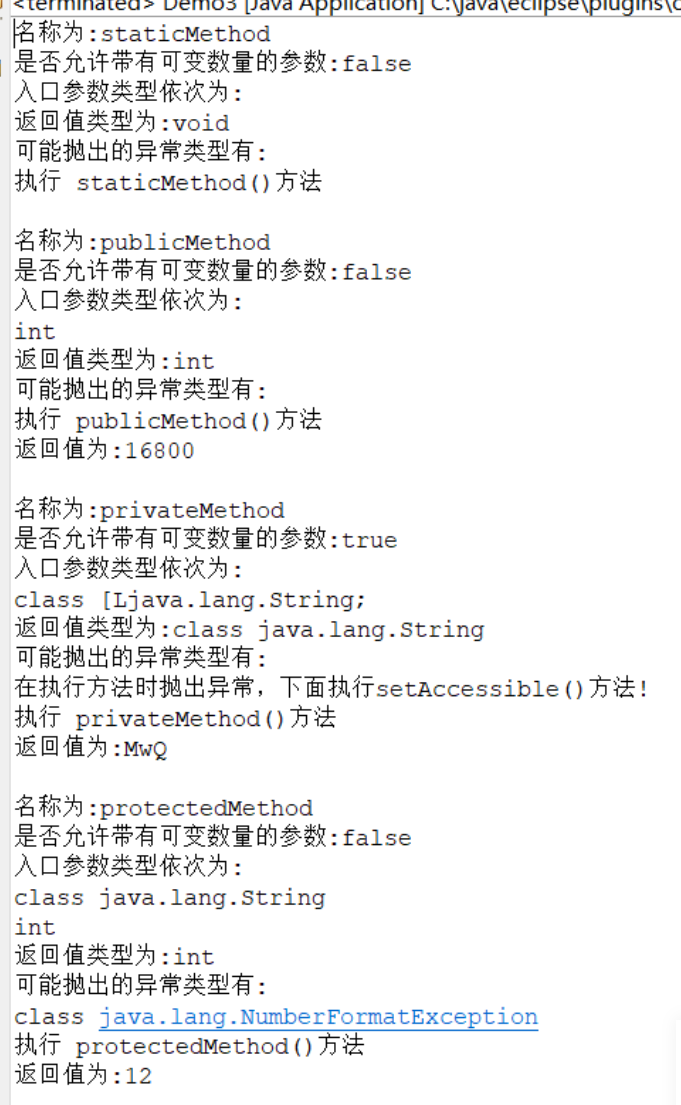
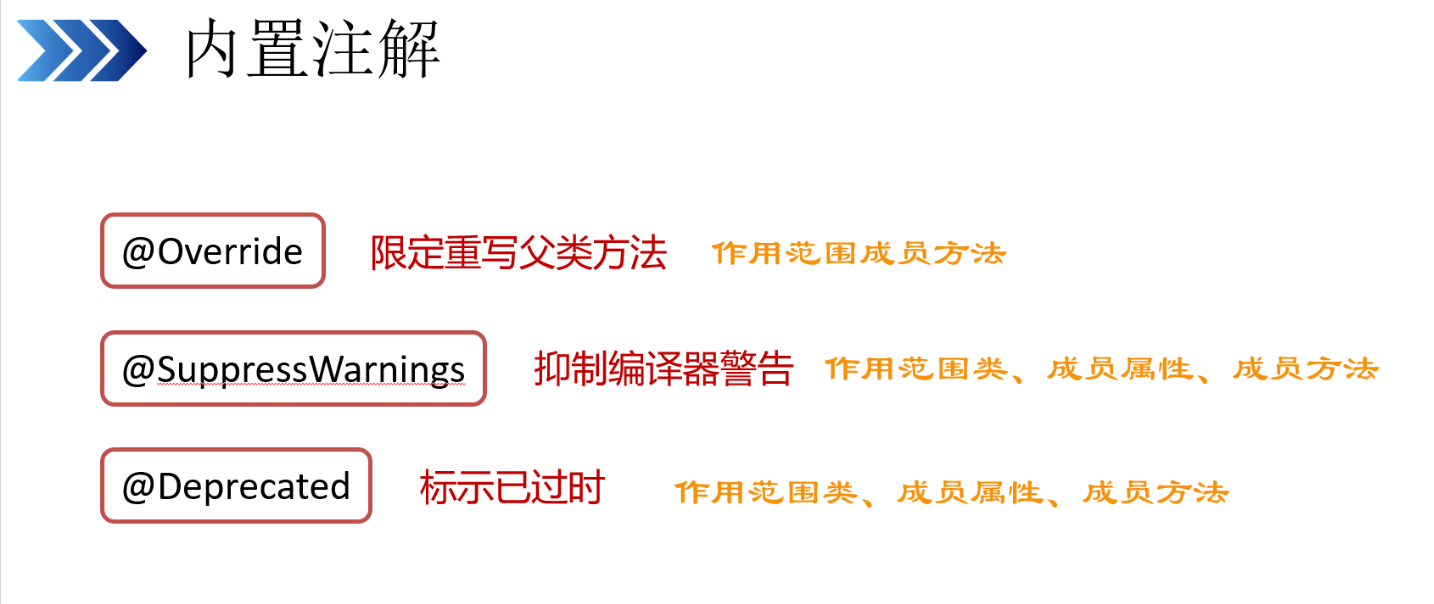
定义Annotation 类型
在定义Annotation类型时,也需要用到用来定义接口的 interface关键字,但需要在interface关键字前加一个“@”符号,即定义Annotation类型的关键字为@interface,这个关键字的隐含意思是继承了java.lang.annotation.Annotation 接口。例如,下面的代码就定义了一个Annotation类型:
public @interface NoMemberAnnotation {
}
上面定义的Annotation类型@NoMemberAnnotation 未包含任何成员,这样的Annotation类型被称为marker annotation。下面的代码定义了一个只包含一个成员的Annotation 类型:
public @interface OneMemberAnnotation {
String value();}
- String:成员类型。可用的成员类型有 String、Class、primitive、enumerated 和annotation,以及所列类型的数组。
- value:成员名称。如果在所定义的 Annotation 类型中只包含一个成员,通常将成员名称命名为value。
定义一个包含多个成员的Annotation 类型:
public @interface MoreMemberAnnotation {
String describe();Class type();
}
在为Annotation 类型定义成员时,也可以为成员设置默认值。例如,下面的代码在定义Annotation类型时就为成员设置了默认值:
public @interface DefaultValueAnnotation {
String describe() default"<默认值>”;Class type() default void.class;
}
在定义Annotation 类型时,还可以通过 Annotation 类型@Target 来设置Annotation 类型适用的程序元素种类。如果未设置@Target,则表示适用于所有程序元素。枚举类 ElementType 中的枚举常量用来设置@Targer,如表 16.6 所示。
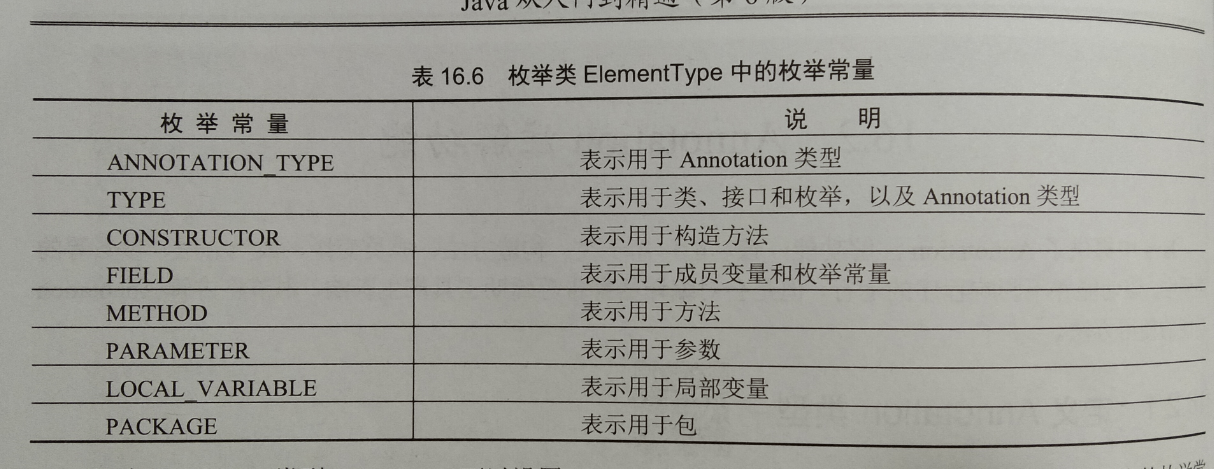
通过Annotation 类型@Retention 可以设置 Annotation 的有效范围。枚举类 RetentionPolicy 中的枚举常量用来设置@Retention,如表 16.7 所示。如果未设置@Retention,Annotation 的有效范围为枚举常量CLASS 表示的范围。

代码案例:

然后定义一个用来注释字段、方法和参数的Annotation类@Field_Method_Parameter_Annotation,有效范围为在运行时加载Annotation到JVM中。完整代码如下:

访问Annotation 信息
如果在定义Annotation类型时将@Retention设置为RetentionPolicy.RUNTIME,那么在运行程序时通过反射就可以获取到相关的Annotation信息,如获取构造方法、字段和方法的Annotation信息。
Constructor 类、Field 类和 Method 类均继承了AccessibleObjiect 类,在AccessibleObject 中定义了3个关于Annotation 的方法。其中,方法isAnnotationPresent(Class<?extends Annotation> annotationClass用来查看是否添加了指定类型的 Annotation,如果是则返回 rue,否则返回 false; 方法getAnnotatiot(Class<T>annotationClass)用来获得指定类型的Annotation,如果存在则返回相应的对象,否则返回nul方法getAnnotations()用来获得所有的Annotation,该方法将返回一个Annotation数组。
在Constructor类和Method 类中还定义了方法 getParameterAnnotations(),用来获得为所有参数添加的Annotation,将以Annotation 类型的二维数组返回,在数组中的顺序与声明的顺序相同。如果没有参数则返回一个长度为0的数组:如果存在未添加Annotation 的参数将用一个长度为0的套数组占位。





















 719
719











 被折叠的 条评论
为什么被折叠?
被折叠的 条评论
为什么被折叠?








